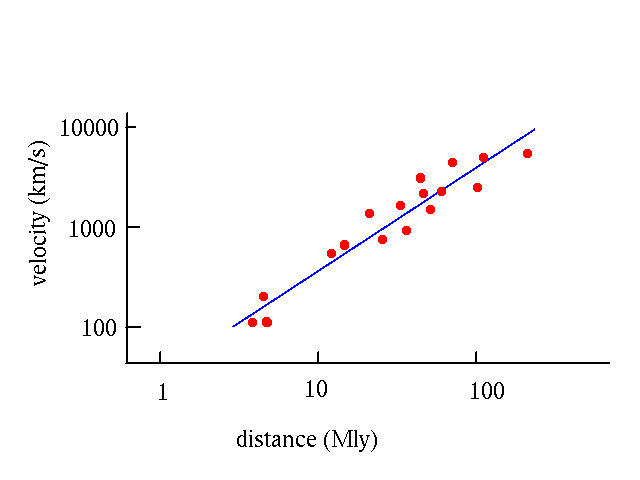How fast are galaxies moving relative to us?
Recall that one can measure how fast a galaxy is moving away from
us or toward us by measuring the Doppler shift of the spectral lines
from the galaxy.
- Blue shift --> moving toward us.
- Bigger shift --> bigger velocity.
- Red shift --> moving away from us.
- Bigger shift --> bigger velocity.
Note that we determine in this way the relative motion of us and the
distant galaxy:
- Red shift --> distance between us and the galaxy is increasing.
- But one could equally well say
- Galaxy X is moving away from us, or
- We are moving away from Galaxy X.
Recall also that one can measure, with some difficulty, how far a galaxy
is from us.
- Measure the brightness of an object with known luminosity.
- For galaxies that are not too far away, Cepheid variable stars
can serve as a good ``standard candle.''
- For galaxies that are further away, one can use the brightness
of supernovae.
- One can also try to use the brightness of whole galaxies. Evidently
this gets complicated.
In the 1920's Hubble investigated the relation between distance to galaxies
and their velocity toward or away from us. He found (as had been noted
earlier) that most galaxies are moving away from us.
In a paper ppublished in 1929, Hubble reported a relation between distance
and velocity, now known as the Hubble law.
Here is a graphical representation of the data for many galaxies

(This graph does not have real data on it, but gives the qualitative
picture.)
From such graphs we learn

The constant H0 is the Hubble constant. Its
value is controversial. The data on the graph above suggest a value
H0 ~ (30 km/s)/Mly
Taking this value we find
- A galaxy 1 Mly from us would typically be moving away from us with
a velocity of 30 km/s.
- A galaxy 2 Mly from us would typically be moving away from us with
a velocity of 60 km/s.
- A galaxy 10 Mly from us would typically be moving away from us with
a velocity of 300 km/s.
- A galaxy 20 Mly from us would typically be moving away from us with
a velocity of 600 km/s.
- A galaxy 100 Mly from us would typically be moving away from us with
a velocity of 3000 km/s.
- A galaxy 200 Mly from us would typically be moving away from us with
a velocity of 6000 km/s.
Many astronomers would prefer a value
H0 ~ (15 km/s)/Mly.
Consequence
The Hubble law has a profound consequence.
- Galaxies are moving away from us.
- That is, the distance to any other typical Galaxy X is increasing with
time.
- That is, if we go back in time, the distance gets smaller.
- That is, sometime in the past the distance between us and Galaxy X
was 0.
How can we
visualize the expansion?
When did it all start?
Davison E. Soper, Institute of Theoretical Science,
University of Oregon, Eugene OR 97403 USA
soper@bovine.uoregon.edu


